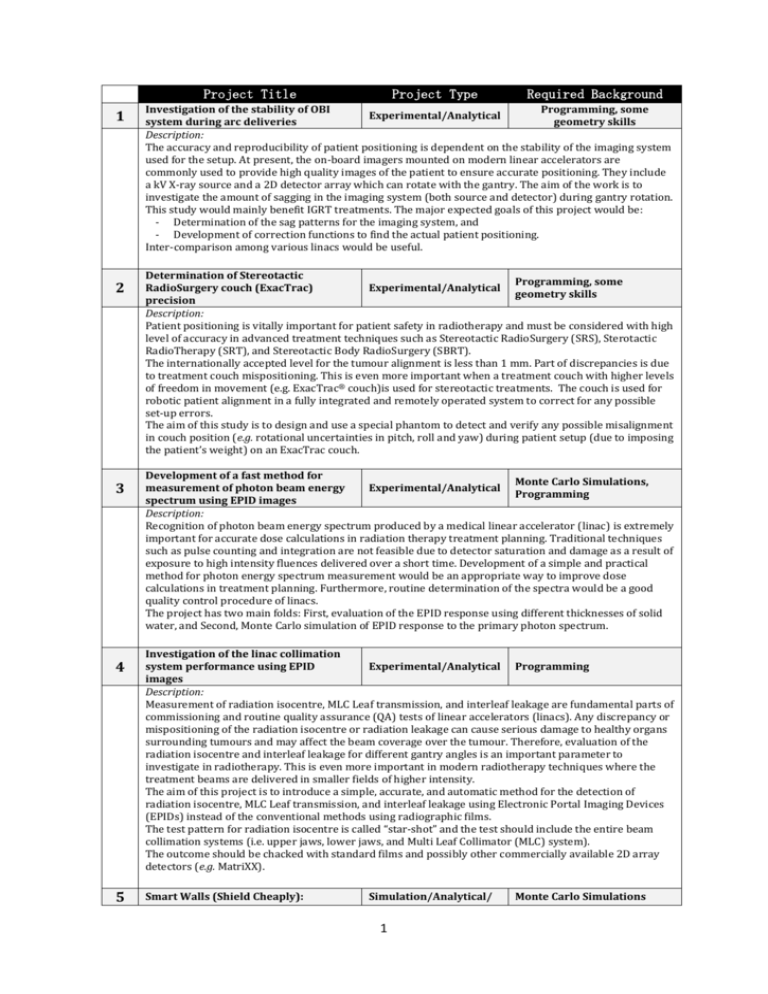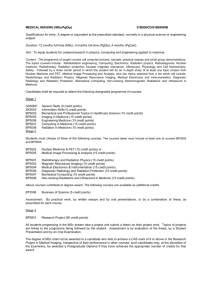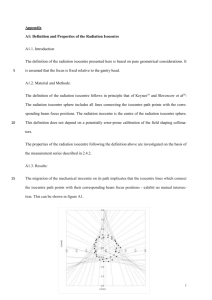Project Title
advertisement

Project Title 1 2 3 4 5 Project Type Required Background Investigation of the stability of OBI Programming, some Experimental/Analytical system during arc deliveries geometry skills Description: The accuracy and reproducibility of patient positioning is dependent on the stability of the imaging system used for the setup. At present, the on-board imagers mounted on modern linear accelerators are commonly used to provide high quality images of the patient to ensure accurate positioning. They include a kV X-ray source and a 2D detector array which can rotate with the gantry. The aim of the work is to investigate the amount of sagging in the imaging system (both source and detector) during gantry rotation. This study would mainly benefit IGRT treatments. The major expected goals of this project would be: - Determination of the sag patterns for the imaging system, and - Development of correction functions to find the actual patient positioning. Inter-comparison among various linacs would be useful. Determination of Stereotactic Programming, some RadioSurgery couch (ExacTrac) Experimental/Analytical geometry skills precision Description: Patient positioning is vitally important for patient safety in radiotherapy and must be considered with high level of accuracy in advanced treatment techniques such as Stereotactic RadioSurgery (SRS), Sterotactic RadioTherapy (SRT), and Stereotactic Body RadioSurgery (SBRT). The internationally accepted level for the tumour alignment is less than 1 mm. Part of discrepancies is due to treatment couch mispositioning. This is even more important when a treatment couch with higher levels of freedom in movement (e.g. ExacTrac® couch)is used for stereotactic treatments. The couch is used for robotic patient alignment in a fully integrated and remotely operated system to correct for any possible set-up errors. The aim of this study is to design and use a special phantom to detect and verify any possible misalignment in couch position (e.g. rotational uncertainties in pitch, roll and yaw) during patient setup (due to imposing the patient’s weight) on an ExacTrac couch. Development of a fast method for Monte Carlo Simulations, measurement of photon beam energy Experimental/Analytical Programming spectrum using EPID images Description: Recognition of photon beam energy spectrum produced by a medical linear accelerator (linac) is extremely important for accurate dose calculations in radiation therapy treatment planning. Traditional techniques such as pulse counting and integration are not feasible due to detector saturation and damage as a result of exposure to high intensity fluences delivered over a short time. Development of a simple and practical method for photon energy spectrum measurement would be an appropriate way to improve dose calculations in treatment planning. Furthermore, routine determination of the spectra would be a good quality control procedure of linacs. The project has two main folds: First, evaluation of the EPID response using different thicknesses of solid water, and Second, Monte Carlo simulation of EPID response to the primary photon spectrum. Investigation of the linac collimation system performance using EPID Experimental/Analytical Programming images Description: Measurement of radiation isocentre, MLC Leaf transmission, and interleaf leakage are fundamental parts of commissioning and routine quality assurance (QA) tests of linear accelerators (linacs). Any discrepancy or mispositioning of the radiation isocentre or radiation leakage can cause serious damage to healthy organs surrounding tumours and may affect the beam coverage over the tumour. Therefore, evaluation of the radiation isocentre and interleaf leakage for different gantry angles is an important parameter to investigate in radiotherapy. This is even more important in modern radiotherapy techniques where the treatment beams are delivered in smaller fields of higher intensity. The aim of this project is to introduce a simple, accurate, and automatic method for the detection of radiation isocentre, MLC Leaf transmission, and interleaf leakage using Electronic Portal Imaging Devices (EPIDs) instead of the conventional methods using radiographic films. The test pattern for radiation isocentre is called “star-shot” and the test should include the entire beam collimation systems (i.e. upper jaws, lower jaws, and Multi Leaf Collimator (MLC) system). The outcome should be chacked with standard films and possibly other commercially available 2D array detectors (e.g. MatriXX). Smart Walls (Shield Cheaply): Simulation/Analytical/ 1 Monte Carlo Simulations Calculation and design of a costExperimental effective material for radiotherapy treatment room shielding Description: Shielding cost and occupancy are the two big considerations in building design for radiotherapy facilities. The aim of this study is to investigate various materials, minerals, and nano-particles for shielding against high-energy X-rays and neutrons in linear accelerator treatment rooms when the beam is on. Concrete is the conventional material that has been used for treatment room shielding design for many years. However, design of thinner radiation shielding would be cost-effective. This can be achieved based on the shielding plan requirements, identification of high-risk areas, and identification of more efficient materials considering the beam type and energy. The project is mainly based on Monte Carlo simulations and results can be benchmarked using special detectors. 6 Introduction of a fast method for quality assurance of electron beams Experimental/Analytical Programming using EPIDs Description: Quality control of electron beams is an important task for the medical physicist in the clinic. This procedure usually is time consuming and costly using either films or 2D array detectors (e.g. profiler, MapCheck, … ) . The purpose of this work is to determine whether an a-Si EPID can be used to measure the consistency of electron beam parameters in a manner similar to that used for photon beams. The project will include evaluation of the optimum additional build-up material and thickness, followed by characterization of the EPID in terms of: Dosimetric linearity Dose rate dependence Short-term reproducibility And characterization of the electron beam in terms of: Radiation field size and penumbra Beam flatness and symmetry The consistency of these parameters over the long period of time (long term reproducibility) is a necessary step toward using EPIDs for routine QA. 7 8 Determination of the internal medical Math, programming, radiation dose received from new Analytical Simulations therapeutic radioisotopes Description: Dosimetry of distributed radionuclides for therapeutic or diagnostic purposes is an important field of study in nuclear medicine and dosimetry. Radiation dose from internal emitters cannot be measured directly; it can only be calculated. The calculated dose is based on both physical and biological factors. The physical factors include the type and energy of radiation and the radiobiological half-life. Biological factors include the distribution of radioisotope in the body and its kinetic behaviour, such as absorption rates, turnover rates, and retention times in various organs and tissues. The biological factors for internal dosimetry are derived from pharmacologically derived bio-kinetic models of the in-vivo behaviour of radioisotopes. In order to properly calculate the absorbed dose to a tissue during nuclear medicine procedures, we need to accurately assess the radionuclide distribution in the body, know how many times the radionuclides decay, and how much of the energy they emit gets deposited in the tissue of interest. As the absorbed dose cannot be measured directly the aim of this study is to use simulation techniques such as Monte Carlo calculations for some radiopharmaceuticals. Determination of the level of complexity for dynamic IMRT and Experimental/Analytical Programming VMAT treatment plans Description: Latest technologies in radiotherapy treatments are highly complex and complicated therefore rigid quality assurance methods are required to ensure correct dose delivery to the patients. Different treatment plans have various levels of complexity and beam modulation in their treatment beams. Parameters like the aperture size, variation of the beam shape, and changes in the beam fluence are the main factors in determination of the degree of complexity of a plan. Some researchers have worked on this topic and introduced a single value to explain the level of complexity for treatment plans and have called it the modulation complexity score (MCS). The aim is to pay more attention to plans with higher MCS 2 scores. By introduction of treatment techniques such as dynamic IMRT and VMAT, the modulation in treatment beams are even higher and these have not been considered in the existing MCS yet. The aim of this project is to consider the extra levels of freedom in beam modulation for dynamic IMRT and VMAT plans, and provide a new modified version of the MCS calculation for better assessment of the treatment plans before the dose is delivered to patients based on plan complexity, organ and target position. 9 10 Head scatter in IMRT/VMAT: A Simulation/Analytical/ Monte Carlo Simulations, comparison between different linacs Experimental Programming and impact on patient dose Description: During radiotherapy treatments with linacs, the scattered radiation (X-rays or neutrons) that mainly originate from the gantry head components may cause extra unnecessary exposure to normal organs and healthy tissues. The level of scattered radiation and its characteristics varies from beam to beam and also depends on treatment techniques. The aim of this study is to first simulate the gantry head using Monte Carlo codes and estimate the amount of scatted/backscattered radiation, and the characteristics of these photons/neutrons. Results can be evaluated by comparison to measurements. The method is expected to be applicable to different techniques and treatment plans as well as flattening filter free linear accelerators. The amount of patient exposure can be compared for different treatment techniques. Investigation of the stability of OBI system during arc deliveries Experimental/Analytical Image processing and programming, some geometry skills Description: The accuracy and reproducibility of patient positioning is dependent on the stability of the imaging system used for the setup. At present, the on-board imagers mounted on modern linear accelerators are commonly used to provide high quality images of the patient to ensure accurate positioning. They include a kV X-ray source and a 2D detector array which can rotate with the gantry. The aim of the work is to investigate the amount of sagging in the imaging system (both source and detector) during gantry rotation. This study would mainly benefit IGRT treatments. The major expected goals of this project would be: - Determination of the sag patterns for the imaging system, and - Development of correction functions to find the actual patient positioning. - Inter-comparison among various linacs would be useful. 11 12 Using EPIDs to characterize the MLC performance in stereotactic Experimental/Analytical Programming radiotherapy Description: In stereotactic radiotherapy, high doses of radiation are delivered to small target volumes. Most treatments are based on MLC or micro-MLC collimation systems. Therefore, it is essential to comprehensively characterize the MLC behaviour for such treatments. The specifications which need to be investigated include: - Leaf positioning and reproducibility, - Transmission and inter-leaf leakage, - Tongue and groove effect, - Penumbra region. - The results can be compared to stereotactic cones. Prediction of excitation functions for Computer Literacy, cyclotron production of therapeutic Theoretical/Analytical Programming skills would be radionuclides desirable Description: Potential radionuclides for therapeutic applications should be listed and grouped. Each student can work on one group of radioisotopes. The optimum target material should be selected by running ALICE and TALYS codes to find the excitation functions (EF) for the target. The predicted yield can then be calculated as a function of target thickness. The next steps would be: - Comparison of the predicted EFs to the experimental data provided by the IAEA, - Comparison of the predicted production yield with the IAEA data bank. - The optimum production method can be selected based on these results. 3 Project Title Project Type Required Background 13 Range of inter-cellular signalling Programming. Strong Analytical following irradiation mathematics. Description: When cells in tissues are exposed to radiation they produce molecular signals which can communicate that exposure to other (non-exposed) cells. The cells receiving the signal can respond as if they were irradiated (by dying). This is known as the ‘bystander effect’. Such an effect has been demonstrated in cell cultures but is difficult to study in a real tissue. Mathematical models offer ways of translating laboratory results to the real tissue situation. This project will involve taking the laboratory evidence on bystander effects and building a mathematical model to simulate real tissues. This will include diffusion equations and solving the relevant partial differential equations for simple situations. The model will be applied to real radiotherapy situations. This work will be undertaken collaboratively with researchers in Belfast, Northern Ireland. There is potential to extend this to a PhD project. 14 Percolation models in radiotherapy Analytical Programming. tissue response Description: When radiotherapy is used to treat a cancer, healthy tissues near the cancer receive some radiation. The pattern of radiation dose to those tissues influence how they respond, and mathematical models can be used to describe that pattern. This project will involve taking data from studies of a couple of healthy tissues (kidneys and gastro-intestinal structures) and examining whether percolation theory can be used to model the resulting tissue response. Percolation theory describes how the response of localised ‘voxels’ in 2D or 3D space can be collected together to describe the response of the whole space. This approach will be compared with other proposed models to describe spatial tissue response to radiotherapy. 15 Quality factors impacting radiotherapy Analytical/experimental Programming. Statistics. trial outcomes Description: Clinical trials in radiotherapy are used to assess one treatment technique against another. This is done most effectively when the collected data is of the highest possible quality. This project will consist of two parts – the first being to assess the impact of quality assurance (QA) methods on disease progression for patients enrolled on the Australasian RADAR prostate radiotherapy trial. This will require using survival statistics to assess the impact of QA-related variables. The second part will involve undertaking measurements of complex treatments to assess the impact of quality on dose delivery relative to the position of the tumour and normal tissues, in order to build a hypothesis on the likely impact of QA of complex treatments on clinical trial outcomes. There is potential to extend this to a PhD project. 16 Testing the QUANTEC normal tissue Analytical Programming. toxicity guidelines on real clinical data Description: We have collected data on a large number of patients treated for prostate cancer during a clinical trial known as RADAR. We now know what side-effects (toxicities) patients had due to the treatment. We wish to test/validate previously published guidelines on the associated toxicities. The QUANTEC guidelines were published in 2010 and will be used by many centres in guiding treatment of patients. An independent validation of the guidelines will increase the faith those centres have in using the QUANTEC guidelines. 4









